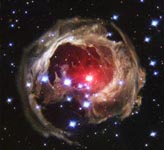Space dust from dead star may unlock mysteries of early universe
 London, Feb 26 : A new research by a team led by the University of Nottingham, UK, has identified interstellar space dust from a dead star, which could unlock some of the mysteries of the early universe.
London, Feb 26 : A new research by a team led by the University of Nottingham, UK, has identified interstellar space dust from a dead star, which could unlock some of the mysteries of the early universe.
Interstellar dust is found throughout the cosmos. It is responsible for the dark patches seen in the Milky Way on a moonless night.
It consists of carbon and silicate particles, about the size of those in cigarette smoke.
The dust helps stars like the Sun to form and subsequently coagulates to form planets like Earth and the cores of giant gas planets like Jupiter. It is found in huge quantities in galaxies, even very early in the history of the universe.
But, the origin of all this dust is a mystery.
It has been suggested earlier that the dust might be produced in supernovae - the violent death-throes of massive stars.
Supernovae are an efficient way of producing dust in a blink of the cosmic eye, as massive stars evolve relatively quickly, taking a few million years to reach their supernova stage.
But, despite many decades of research, astronomers have still not found conclusive evidence that supernovae can produce dust in the quantities required to account for the dust they see in the early universe.
Now, Dr Loretta Dunne and her team have found new evidence of huge dust production in the Cassiopeia A supernova remnant, the remains of a star that exploded about 300 years ago.
Using the SCUBA polarimeter on the James Clerk Maxwell Telescope in Hawaii, the scientists searched for a signal from dust grains spinning in the strong magnetic field of the supernova remnant.
If the dust grains are slightly elongated (like little cigars), they tend to line up the same way and produce a polarised signal.
When the polarimeter detector is rotated, the strength of the signal changes - much the same as if you look at the sky with polaroid sunglasses, held at different angles.
The polarisation signal from the supernova dust is the strongest ever measured anywhere in the Milky Way, marking it out as unusual.
It emits more radiation per gram than regular interstellar dust and the alignment of the grains must be very orderly to produce such highly polarised emission.
"It is like nothing we've ever seen," said Dr Dunne, who is based in the Centre for Astronomy and Particle Physics at The University of Nottingham.
"It could be that the extreme conditions inside the supernova remnant are responsible for the strong polarised signal, or it could be that the dust grains themselves are highly unusual," she added. (ANI)